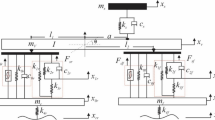Abstract
Growing customer requirements for comfort of vehicles more often become refer to vibrations that affect the people in transport. At the same time each car put into service must has the appropriate parameters traction to the road surface responsible for the safety. Due to the nature of the vibration transmitted to the vehicle body vibration requirements are of the often contradictory. Therefore, an intense research on modern control systems, active vibration damping system parameters are require. This paper presents the advantages and disadvantages associated with the suspension systems of vehicles of conventional and active and semiactiv based on the elements of a controlled characteristics of both elastic elements and damping. It was suggested the possibilities of advanced signal processing methods application developed in vibration research.
Access this chapter
Tax calculation will be finalised at checkout
Purchases are for personal use only
Preview
Unable to display preview. Download preview PDF.
Similar content being viewed by others
References
Maciejewski, M., Osmolski, W., Slaski, G.: Importance of Road Model in Simulation of Car Aerodynamics in a Wind-tunnel. In: Proceedings of 12th European Simulation Symposium, pp. 405–409 (2012)
Girtler, J., Ślęzak, M.: Four-state Stochastic Model of Changes in the Reliability States of a Motor Vehicle. Eksploatacja i Niezawodnosc – Maintenance and Reliability 15(2), 156–160 (2013)
Slaski, G.: A Concept of an Integrated Suspension Control Logic Architecture and its Testin. In: Proceedings of 5th International Industrial Simulation Conference, pp. 201–205 (2007)
Jurecki, R., Stańczyk, T.: The Test Methods and the Reaction Time of Drivers. Eksploa-tacja i Niezawodnosc - Maintenance and Reliability (3), 84–91 (2011)
Nader, M.: The Influence of Mechanical Vibrations on the Driver’s Body. Journal of Biomechanics 27(6), 716 (1994)
Dąbrowski, D., Batko, W., Cioch, W.: Model of the Gears Based on Multibody System and its Validation by Application of Non-contact Methods. Acta Physica Polonica A 123(6), 1016–1019 (2013)
Cioch, W., Knapik, O., Leskow, J.: Finding a frequency signature for a cyclostationary signal with applications to wheel bearing diagnostics. Mechanical Systems and Signal Processing 38(1), Special Issue: SI 55–64 (2013)
Kłaczyński, M., Wszołek, T.: Artificial Intelligence and Learning Systems Methods in Supporting Long-Term Acoustic Climate Monitoring. Acta Physica Polonica A 123(6), 1024–1028 (2013)
Kłaczyński, M., Wszołek, T.: Detection and Classification of Selected Noise Sources in Long-Term Acoustic Climate Monitoring. Acta Physica Polonica A 121(1-A), A-179–A-182 (2012)
Dąbrowski, Z., Deuszkiewicz, P.: Nonlinear Dynamic Model of a Carbon-Epoxy Composite Structure. In: 20th International Congress On Sound & Vibration (2013)
Blacha, Ł., et al.: Application of the weakest link analysis to the area of fatigue design of steel welded joints. Engineering Failure Analysis 35 Special Issue: SI, 665–677 (2013)
Lisiecki, A.: Welding of Titanium Alloy by Disk Laser. In: Proc. of SPIE. Laser Technology 2012: Applications of Lasers, vol. 8703, p. 87030T (2013)
Węgrzyn, T., et al.: Control Over the Steel Welding Structure Parameters by Micro-Jet Cooling. Archives of Metallurgy And Materials 57(3), 679–684 (2012)
Kubo, M., et al.: An investigation into a synthetic vibration model for humans: An investigation into a mechanical vibration human model constructed according to the relations between the physical, psychological and physiological reactions of humans exposed to vibration. International Journal of Industrial Ergonomics 27, 219–232 (2001)
Nishiyama, S.: Development of simulation system on vehicle±occupant dynamic interaction. Transactions of the Japan Society of Mechanical Engineers Seriese-C 59 568, 1004–1012 (1993)
Burdzik, R.: Implementation of multidimensional identification of signal characteristics in the analysis of vibration properties of an automotive vehicle’s floor panel. Eksploatacja i Niezawodnosc – Maintenance and Reliability Volume 16(3), 439–445 (2014)
Burdzik, R.: Identification of structure and directional distribution of vibration transferred to car-body from road roughness. Journal of Vibroengineering 16(1), 324–333 (2014)
Dixon, J.: The Shock Absorber Handbook, 2nd edn. Professional Engineering Publishing Ltd. (2007)
Balamurugan, L., Jancirani, J., Eltantawie, M.: Generalized Magnetorheological (MR) Damper Model and its Application in Semi-active Control of Vehicle Suspension System. International Journal of Automotive Technology 15(3), 419–427 (2014)
Snamina, J., Kowal, J., Orkisz, P.: Active Suspension Based on Low Dynamic Stiffness. Acta Physica Polonica A 123(6), 1118–1122 (2013)
Ho, C., Lang, Z.Q., Sapinski, B.: Vibration isolation using nonlinear damping implemented by a feedback-controlled MR damper. Smart Materials And Structures 22(10) Special Issue: SI, Article Number: 105010 (2013)
Seung-Bok, C., Yun-Hae, K., Prasad, Y.: Development of an Novel Adaptive Suspension System Based on Ball-Screw Mechanism. Applied Mechanics and Materials 477-478, 128 (2001)
Kowal, J.: Sterowanie drganiami. Gutenberg (1996)
Ł ęgiewicz, J.: Zawieszenia półaktywne, Auto Moto Serwis 1/2005, 29–32 (2005)
Karoń, G., Mikulski, J.: Transportation Systems Modelling as Planning, Organisation and Management for Solutions Created with ITS. In: Mikulski, J. (ed.) TST 2011. CCIS, vol. 239, pp. 277–290. Springer, Heidelberg (2011)
Mikulski, J.: Introduction of telematics for transport. In: Proceedings on 9th International Conference ELEKTRO 2012, Rajecke Teplice, IEEE Catalog Number CFP1248S-ART, May 21-22, pp. 336–340 (2012), ieexplore.ieee.org
Author information
Authors and Affiliations
Editor information
Editors and Affiliations
Rights and permissions
Copyright information
© 2014 Springer-Verlag Berlin Heidelberg
About this paper
Cite this paper
Burdzik, R., Konieczny, Ł., Adamczyk, B. (2014). Automatic Control Systems and Control of Vibrations in Vehicles Car. In: Mikulski, J. (eds) Telematics - Support for Transport. TST 2014. Communications in Computer and Information Science, vol 471. Springer, Berlin, Heidelberg. https://doi.org/10.1007/978-3-662-45317-9_13
Download citation
DOI: https://doi.org/10.1007/978-3-662-45317-9_13
Publisher Name: Springer, Berlin, Heidelberg
Print ISBN: 978-3-662-45316-2
Online ISBN: 978-3-662-45317-9
eBook Packages: Computer ScienceComputer Science (R0)




